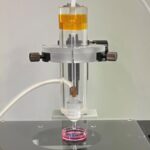
In a groundbreaking study that sheds light on the elusive neural mechanisms underpinning motion sickness, researchers have identified a specific subset of neurons within the medial vestibular nuclei parvocellular part (MVePC) that orchestrate the complex physiological responses linked to motion-induced discomfort. This discovery not only unravels the neural circuitry connecting motion detection to thermoregulation and metabolic control but also paves the way for innovative therapeutic interventions targeting both motion sickness and metabolic disorders such as obesity.
Motion sickness, a widespread and often debilitating condition, has long been associated with disruptions in bodily homeostasis, including altered temperature regulation and metabolic imbalance. Despite its prevalence, the precise neural pathways that translate vestibular sensory inputs into these systemic responses have remained largely enigmatic. The new research directly addresses this gap by pinpointing glutamatergic neurons in the MVePC—termed MVePC^Glu neurons—as pivotal mediators linking vestibular processing to downstream physiological effects.
Leveraging advanced neurotechnological tools, the investigators employed optogenetics to selectively stimulate MVePC^Glu neurons in murine models. This targeted activation recapitulated the hallmark hypothermic response characteristic of motion sickness, thereby establishing a causal relationship between these neurons’ activity and thermoregulatory changes. Intriguingly, this hypothermia was transmitted via projections from the MVePC^Glu neurons to the lateral parabrachial nucleus (LPBN), highlighting a discrete neural pathway dedicated to integrating vestibular signals with autonomic outputs that regulate body temperature.
The lateral parabrachial nucleus has long been recognized as a hub for processing nociceptive and visceral sensory information, as well as for mediating thermoregulatory adjustments. By demonstrating that optogenetic stimulation of MVePC^Glu terminals within the LPBN is sufficient to induce hypothermia, the study reveals a previously unappreciated circuit that bridges vestibular inputs with central thermoregulatory centers. Conversely, acute inhibition of this MVePC-LPBN pathway effectively abolished motion-induced hypothermia, confirming its essential role in the manifestation of sickness-driven temperature changes.
Beyond elucidating motion sickness mechanisms, the research delved into the broader metabolic ramifications of manipulating MVePC^Glu neuron activity. Chronic inhibition of these neurons yielded remarkable metabolic benefits in the mice, including resistance to diet-induced obesity and improved glucose homeostasis. Notably, these improvements occurred without any reduction in food intake, suggesting that modulation of MVePC^Glu neurons influences energy expenditure or metabolic efficiency rather than appetite per se. Such findings implicate the vestibular system as a novel player in systemic energy balance and highlight potential neural targets for combating obesity and related metabolic dysfunctions.
This study’s sophisticated use of reactivation protocols further strengthened the functional link between MVePC^Glu neurons and motion sickness phenotypes. By reactivating motion-sensitive ensembles within the MVePC in animals previously exposed to provocative motion, researchers induced behaviors reminiscent of motion sickness, thereby confirming the sufficiency of these neurons in driving sickness-associated responses. This work elegantly demonstrates how discrete populations within the vestibular nuclei encode complex multisystem outputs beyond mere motion perception.
The implications of this research extend far beyond the laboratory bench. Motion sickness remains a significant impediment to travel, space exploration, and virtual reality applications. Current treatments are limited and often accompanied by side effects. By uncovering the precise neural circuits responsible for motion-induced hypothermia and sickness behaviors, therapeutics can be more precisely targeted, minimizing undesirable consequences while maximizing efficacy. Additionally, the unexpected metabolic improvements engendered by MVePC^Glu neuron suppression hint at novel interventional avenues for metabolic diseases, potentially leading to dual-purpose treatments that alleviate motion sickness symptoms while promoting metabolic health.
Integrated within this neural framework is the concept that the vestibular system serves as more than just a sensorimotor determinant of balance and spatial orientation; it acts as a critical regulator of systemic physiological states. The MVePC, previously underappreciated in its influence on homeostasis, emerges as a key node linking environmental sensory stimuli to internal bodily adaptations. This paradigm shift calls for further exploration into vestibular contributions to disorders beyond motion sickness and metabolic syndrome, possibly encompassing neuropsychiatric and inflammatory conditions where autonomic dysregulation is evident.
The identification of MVePC^Glu neurons as glutamatergic emphasizes the excitatory nature of the signals driving downstream hypothermic and metabolic effects. Glutamate’s role as a primary excitatory neurotransmitter underscores the potential for fine-tuned modulation via synaptic or receptor-level interventions. Pharmacological agents targeting glutamatergic transmission within this circuit, or neuromodulatory techniques such as targeted deep brain stimulation, might offer new therapeutic modalities aligned with the physiological underpinnings unveiled by this research.
Methodologically, the employment of optogenetics allowed for unprecedented temporal and spatial specificity in dissecting neuronal circuits. This approach enabled the reversible manipulation of defined neuronal populations to causally link anatomical substrates with behavioral and physiological outputs. Complemented by genetic labeling strategies, functional reactivation paradigms, and metabolic phenotyping, the multi-disciplinary approach exemplifies the future of neuroscience research where integrated techniques offer comprehensive insights.
Furthermore, this research highlights the importance of cross-talk between sensory systems and metabolic pathways. Such integrative physiology reflects the organism’s need to dynamically adjust to environmental challenges, such as motion, by recalibrating energy budgets and thermoregulatory processes. Understanding how these systems interact at the neural level provides a blueprint for unraveling complex adaptive behaviors and pathologies arising from their malfunction.
In the context of obesity, a major global health crisis, the revelation that vestibular neurons impact energy balance independently of food intake is particularly striking. Current obesity therapies predominantly focus on appetite suppression or nutrient absorption. The newly identified MVePC^Glu neurons offer a complementary strategy centered on metabolic modulation, potentially circumventing common hurdles in weight management such as compensatory overeating.
The convergence of sensory processing, autonomic control, and metabolic regulation within the MVePC-LPBN axis also raises fascinating questions about the evolutionary and adaptive significance of this circuitry. It suggests that organisms have evolved integrated systems to anticipate and respond to environmental stimuli that threaten physiological equilibrium, employing behavioral and autonomic responses coordinated through discrete neural networks.
Looking ahead, this research opens several exciting avenues. Future investigations might examine whether similar circuits exist in humans and how these pathways can be harnessed or modulated in clinical populations suffering from motion sickness or metabolic diseases. Additionally, exploring the interactions between vestibular signaling and other central systems governing mood, cognition, and immune responses could provide a more holistic understanding of how bodily integrity is preserved in the face of internal and external perturbations.
Collectively, the findings mark a significant milestone in neurobiology by unveiling neural substrates that link sensory vestibular input with systemic physiological adjustments. The characterization of MVePC^Glu neurons and their projections to the LPBN instantiates a novel neurobiological axis that controls thermoregulatory and metabolic responses to motion. Beyond expanding fundamental knowledge, this axis represents a promising target for innovative strategies to ameliorate motion sickness and metabolic imbalances, potentially transforming clinical approaches to these pervasive conditions.
This trailblazing study exemplifies the power of modern neuroscience to disentangle the multifaceted neural networks underlying complex behaviors and physiological states. By doing so, it bridges the gap between basic science and applied medicine, offering new hope for individuals plagued by motion sickness and metabolic diseases worldwide. The quest to manipulate such circuits safely and effectively is now a tangible goal, heralding a new era in neuromodulation and integrative physiology.
Subject of Research: Neural circuits linking motion sickness, thermoregulation, and metabolic control mediated by glutamatergic neurons in the medial vestibular nuclei parvocellular part (MVePC) in mice.
Article Title: Vestibular neurons link motion sickness, behavioural thermoregulation and metabolic balance in mice.
Article References:
Tu, L., Fang, X., Yang, Y. et al. Vestibular neurons link motion sickness, behavioural thermoregulation and metabolic balance in mice. Nat Metab 7, 742–758 (2025). https://doi.org/10.1038/s42255-025-01234-9
Image Credits: AI Generated
DOI: https://doi.org/10.1038/s42255-025-01234-9
Tags: glutamatergic neuron functionhomeostasis and motion-induced discomfortinnovative therapies for motion sicknessmetabolic control pathwaysmotion sickness mechanismsMVePC neurons roleneural circuitry of discomfortobesity and vestibular connectionoptogenetics in neurosciencephysiological responses to motionthermoregulation and motion sicknessvestibular neuron research



